316Ti Stainless Steel - 1.4571 - X6CrNiMoTi17-12-2 - S31635
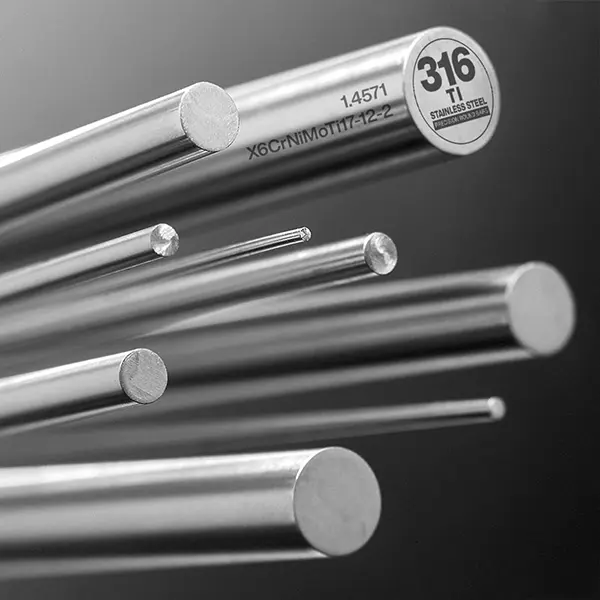
316Ti Stainless Steel - 1.4571 - X6CrNiMoTi17-12-2 - S31635
Back to Steel Overview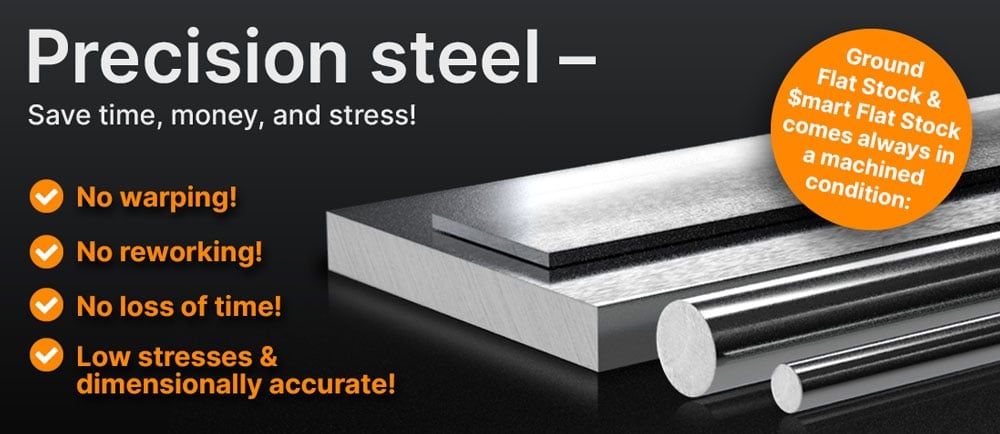
316Ti STEEL PRICE CHART
316 Ti STANDARD VALUES
C
Si
Mn
P
S
Cr
Mo
Ni
Ti
Chemical name:
X6CrNiMoTi17-12-2
Working hardness:
max. < 20 HRC
Delivery condition:
max. 215 HB
X6CrNiMoTi17-12-2
max. < 20 HRC
max. 215 HB
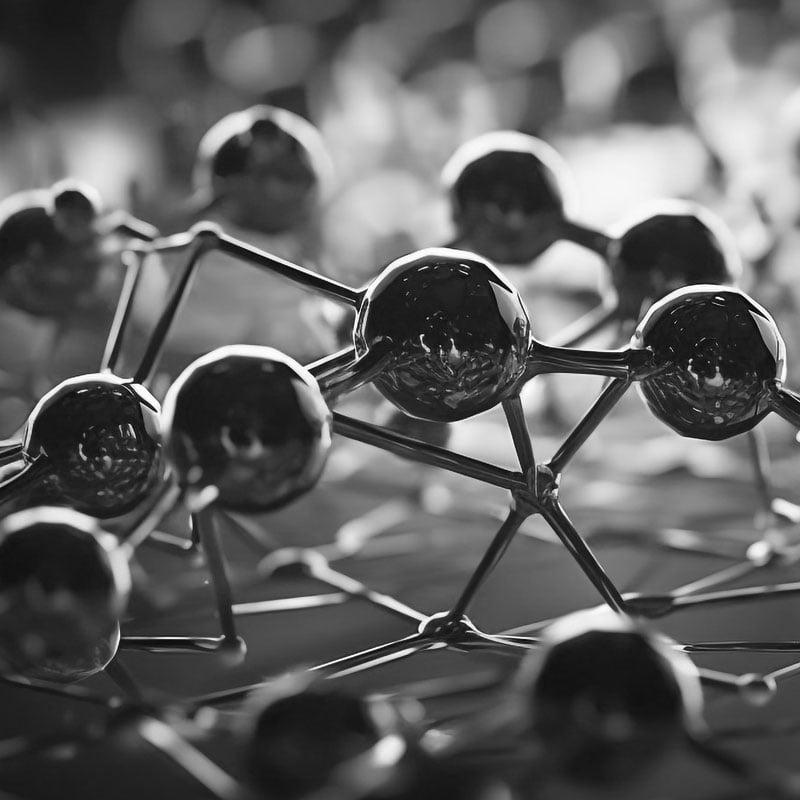
316Ti PHYSICAL PROPERTIES
Like other austenitic steels, stainless steel 316Ti cannot be magnetized. It cannot be hardened by heat treatment. The cold forming of the material causes a change in the microstructure and therefore work hardening, which increases tensile strength, yield strength and hardness
It has very good corrosion resistance, under certain circumstances excellent weldability and high durability, which helps in applications like furnace parts, heat exchangers, brewery equipment and medical implants or for the storage and transportation of e.g., milk.
The 316Ti is with a mass fraction of 16.5 - 18.5% of chromium, a corrosion resistant steel.
316Ti has good resistance to atmosphere, fresh water, fruit and vegetable juices and moderate resistance to diluted acids, like diluted sulphuric acid and hydrochloric acid and is also resistant to intergranular corrosion after welding.
316Ti can be used in air with temperatures up to 1560°F (850°C) and steam with temperatures up to 1380°F (750°C).
Corrosion resistance is reduced in Sulphurous flue-gasses. In such environments, 316Ti can be used at temperatures up to 1110 - 1380°F (600 - 750°C), depending on service conditions. Consideration must be given to whether the atmosphere is oxidizing or reducing, e.g., the oxygen content, and weather impurities such as sodium and vanadium are present.
With the added Molybdenum in 316Ti it can handle water with up to about 0.017lb/gal. (2,000 ppm) of chloride. Although considered adequate for some applications that are exposed to salt spray, it is not recommended in seawater containing 0.159lb/gal. (19,000 ppm) of chloride.
With the addition of titanium, the precipitation of chromium carbides in the grain boundaries can be prevented after prolonged heating in a temperature range of 840 - 1560°F (450 - 850°C).
Austenitic steels are prone to stress corrosion cracking, as can be encountered at temperatures above 140°F (60°C) when the steel is exposed to tensile stresses or comes into contact for example with solutions containing chlorides at the same time.
No, the 316Ti is generally non magnetic in its annealed condition and is not suitable for magnetic clamping. Some processes like cold work for example can make this material slightly magnetic.
The wear resistance for the 316Ti stainless steel has a wear resistance of 2 on a scale where 1 is low and 6 is high.
Heat the material to a minimum temperature of 1652°F (900°C) and do not let the temperature drop below this temperature. The ideal temperature range is between 2102 - 2300°F (1150 - 1260°C), then cool in air after. To ensure the highest possible corrosion resistance afterwards annealing is recommended.
Stainless 316Ti has good cold forming properties and are suited for brake and roll forming as well as stamping, heading and drawing. To reduce internal stresses a post work annealing is recommended. Cold working increases strength as well as hardness for this steel grade.
316Ti TECHNICAL PROPERTIES
316Ti is not usually taken as knife steel. It does not have the edge retention needed due to the lower carbon. Though it has good toughness which gives it a resistance to chipping and breaking it again jeopardizes edge retention. Even with its great corrosion resistance it is not enough to make this grade a good knife steel as good knife steels have a good balance between hardness and corrosion resistance.
The working hardness for the 316Ti on delivery is max. < 20 HRC.
Typically the density of 316Ti stainless steel is 0.289 lb/in3 (8.0g/cm3) at room temperature.
Stainless steel 316Ti has a tensile strength of approx. 100.0 KSI on delivery (0.145 KSI = 1MPa). In order to reach this value, a tensile test is performed to show how much force is needed to stretch or elongate a sample before it breaks.
The yield strength shows when a material starts deformation beyond the point that it might return to its original shape (plastic deformation). The yield strength is impacted by the carbon content and heat treatment of the various steel grades. The range for the 316Ti stainless steel is approx. 29.73 KSI (205MPa).
The heat conductivity for stainless steel is at 15 W/(m*K) ((104 BTU/(h-ft*°F)) at room temperature.
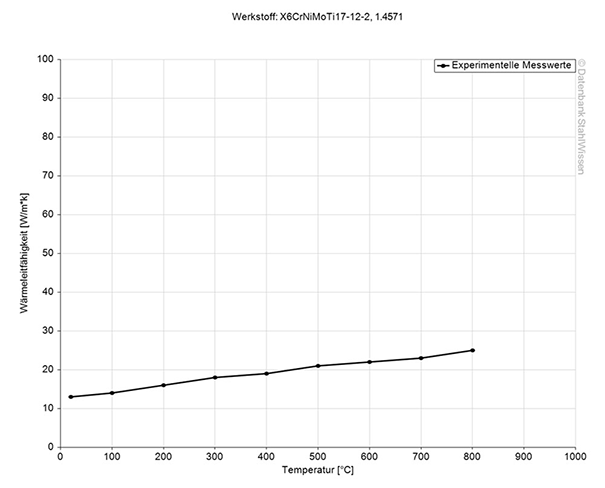
This diagram shows how much 316Ti stainless might expand or contract when the temperatures change which can be very important when working with high temperatures or strong temperature changes.
Medium thermal expansion coefficient | |
10-6m/(m • K) | At a temperature of |
16.5 | 68 - 212°F |
17.5 | 68 - 392°F |
18.0 | 68 - 572°F |
18.5 | 68 - 752°F |
19.0 | 68 - 932°F |
19.0 | 68 - 1112°F |
19.5 | 68 - 1292°F |
19.5 | 68 - 1472°F |
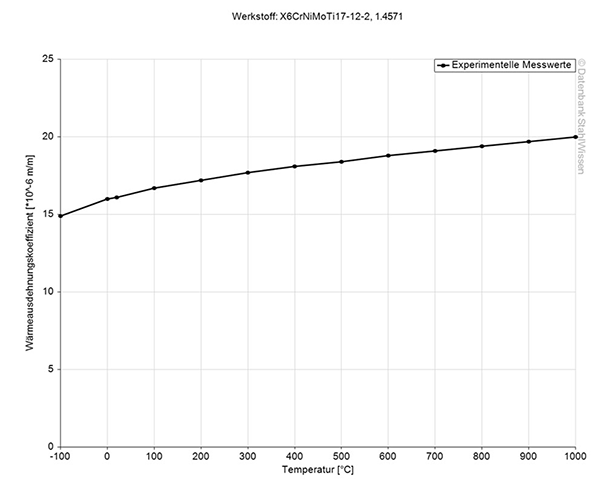
The specific heat capacity for the 316Ti stainless steel at room temperature is 0.5 J/g-°C (0.119 BTU/lb-°F). This value shows how much heat is needed to heat 1lb of material by 1 Fahrenheit.
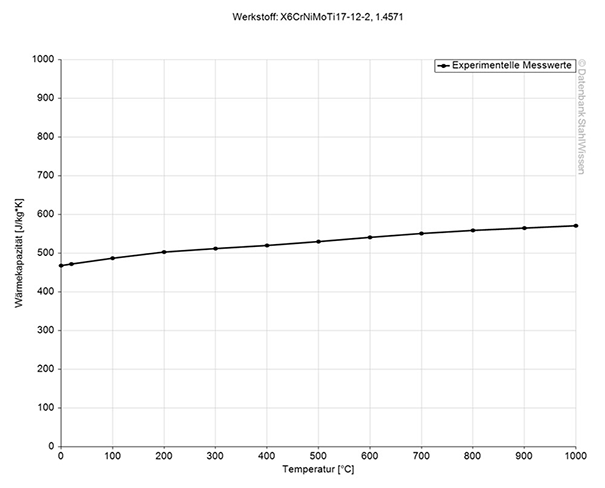
The following table shows the electrical resistivity of stainless steel 316Ti.
Table of the specific electrical resistivity | |
Value | At a temperature of |
0.75 (Ohm*mm²)/m | 68°F |

316Ti AS $MART FLAT STOCK OR DRILL ROD.


316Ti PROCEDURE
To anneal, heat the work piece to 1868 - 2030°F (1020 - 1110°C), then cool in water or air.
Quenching should be done in water for work pieces over 5/64 inch (2 mm) at a temperature of 1868 - 2048°F (1020 - 1120°C) and air for work pieces under 5/64 inch (2 mm).
316Ti SURFACE TREATMENT
This process removes free iron from the surface of the material with nitric or citric acid. Passivation can enhance the already high corrosion resistance of the 316Ti by layering it with a chromium oxide layer.
Abrasive particles like glass or ceramic beads are blasted against the surface to remove contaminants like rust, paint or scale and to promote a uniform matt finish.
Note: Care has to be taken during this process as the process produces dust and small parts might be propelled back. Protective gear like masks, helmets and protective clothing should be worn and adequate ventilation or dust extraction should be provided.
Shot blasting is an impact treatment where multiple high velocity shots are blasted onto the material surface leaving small indentations removing stress risers. It makes the surface more resistant and can prevent fatigue and stress corrosion failure.
Note: Protective gear like goggles, masks, helmets, gloves and protective clothing should be worn and adequate ventilation or dust extraction should be provided.
Appropriate guards to prevent shot spillage should be in place, equipment regularly maintained and shot should be free from contaminants.
PVD deposits a thin film onto the surface of the 316. Though often used as a decorative purpose by giving the material a nice color finish, the PVD film can enhance wear resistance and lubricity.
Electropolishing removes a thin layer of the surface material leaving a smooth, glossy and highly corrosion resistant surface.
316Ti PROCESSING
To avoid excess work hardening keep cutting edges sharp. Lubricants and coolants should be used liberally to avoid heat concentration at the cutting edges. Chip breakers should be employed to keep the workpiece clear.
Plastic deformation from mechanical stresses, phase changes and localized heating and cooling while welding can cause dimensional changes. Like all metal materials the 316Ti will expand and contract with temperature changes at certain temperatures. For more information see diagram of the thermal expansion coefficient below.
Heat the work piece to approx. 2102 - 2156°F (1150 - 1180°C), forging takes place at the temperature range of 2156 - 1742°F (1180 - 950°C) followed by air or water cooling.
Stainless steel 316Ti can be welded with most common welding methods with or without fillers. Gas welding should be avoided as this will risk carburization. A heat treatment is not necessary after welding and tempering colors should be removed chemically or mechanically to maintain the best possible corrosion resistance.
Avoid cross contamination while fabricating, only tools dedicated to stainless steel materials should be used to avoid surface discoloration of the fabricated products. Clean all tooling and work surfaces thoroughly against cross contamination.
316Ti APPLICATION OPTIONS
Due to the stabilizing titanium in this material it can be used in environments with high temperatures as well as in corrosive environments like chlorides or sulphorus environments. It can be used for chemical processing applications and in the pulp and paper industry where chemicals and high temperatures are used/needed.
• Chemical industry
• Textile industry
• Oil industry
• Building industry
• Food industry
• Soap industry
• Paper industry
• Photographic industry
• Paint industry
• Rubber industry
• Mechanical engineering
• Apparatus engineering
• Pump construction
• Compressor construction
• Pipeline construction
• Shipbuilding
• Medical technology
• Pharmaceutical industry
• Nuclear engineering
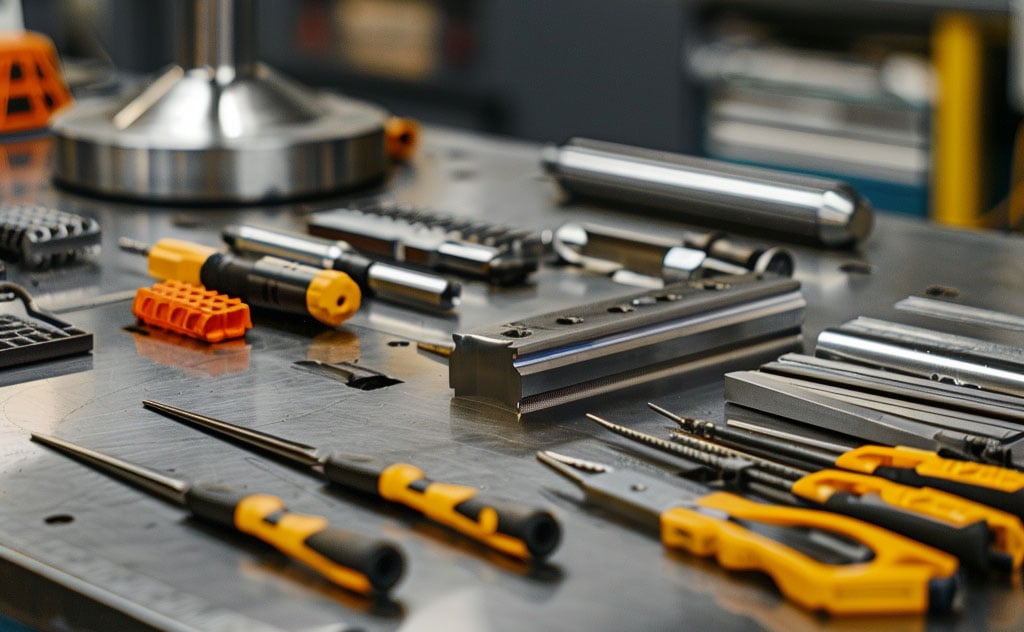
316Ti CONCLUSION
316Ti is an austenitic stainless steel that is resistant to sensitization at high temperatures due to the use of titanium. It is suitable for applications where heat-induced intergranular corrosion is a problem and is suitable for a variety of aggressive environments.
- Austenitic stainless steel
- Austenitic chromium-nickel-molybdenum steel
- Seawater resistant
- Resistant to dilute sulphuric and hydrochloric acid
- Resistant to intergranular corrosion after welding
- Very good cold formability
- Very good weldability
- Non-magnetizable
We offer this steel as 316Ti Flat Stock and Metric 316Ti Cold Finished Round Bars.
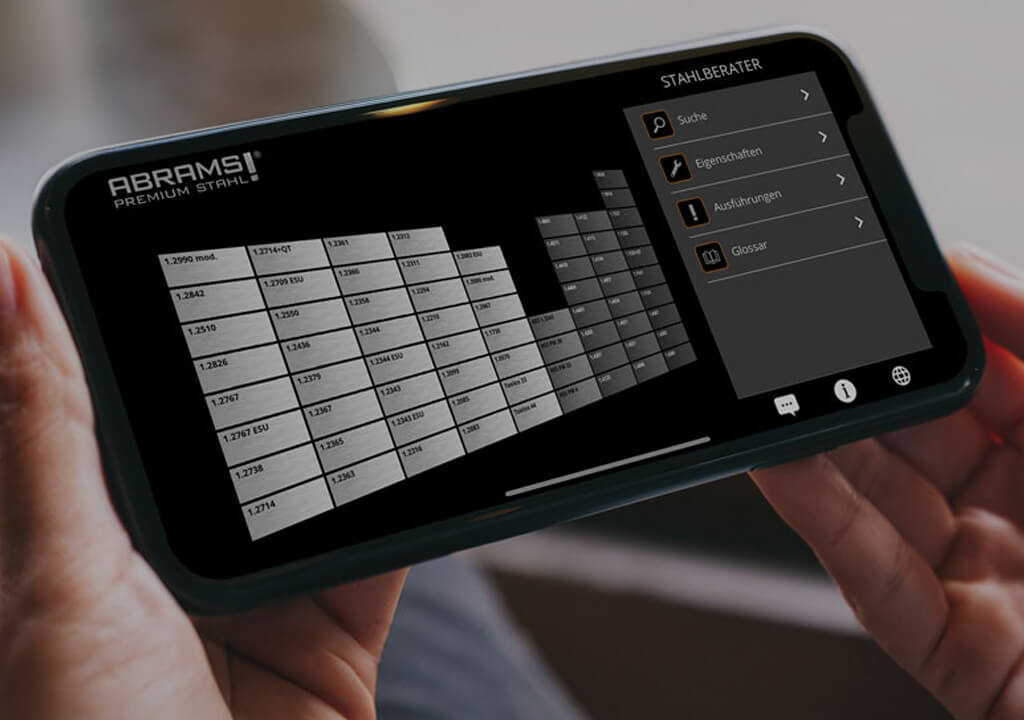
316Ti ALTERNATIVES
Are you looking for an alternative steel grade?
WE HAVE THE SOLUTION!
With the ABRAMS STEEL GUIDE, you can obtain an alternative or equivalent steel grade with just a few clicks.
316Ti DATASHEET
Download the technical data sheet in PDF format here.

The data shown here has been compiled with the greatest diligence and is regularly updated with regard to the correctness and completeness of its content. The content is indicative only and should not be taken as a warranty of specific properties of the product described or a warranty of suitability for a particular purpose. All information presented is given in good faith and no liability will be accepted for actions taken by third parties in reliance on this information. ABRAMS Industries reserves the right to change or amend the information given here in full or parts without prior notice.

